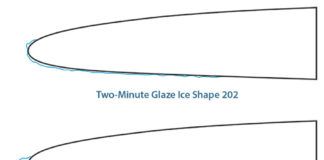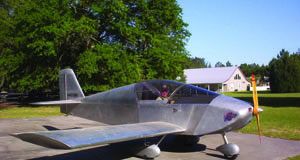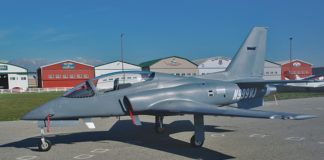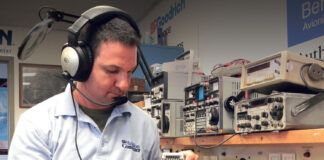The shape of the trailing edge of a flying surface—wing, tail, or control—determines how the air flowing departs downstream as it leaves the surface. Both the direction of this departing flow and the characteristics of the wake it forms are strongly affected by the shape of the trailing edge, and can have quite significant effects on the aerodynamic characteristics of the surface itself.
The trailing edge is also a structurally challenging area; although it is thin, it still must be stiff enough and strong enough to withstand both air and ground-handling loads. There is a natural conflict between the aerodynamic desire for a thin, sharp trailing edge, and the structural challenges inherent in making the trailing edge stiff and strong enough to bear the loads it experiences in flight.
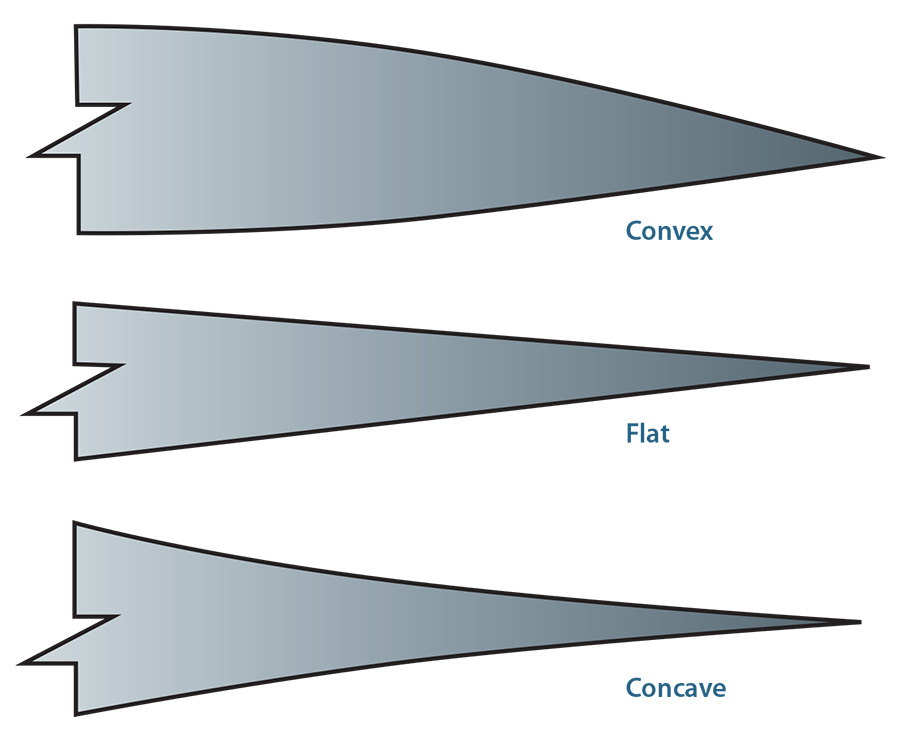
Designers employ various strategies in designing trailing edge shapes. All of them are a compromise between keeping the airflow attached until it can separate smoothly and building a shape that’s structurally sound.
Trailing Edge Flow
Except when a wing is stalled, the air flows smoothly over its surface without separation. When the air reaches the trailing edge, it must separate from the wing. In order for the airfoil to produce lift, the air must flow smoothly downstream from the trailing edge. This situation, in which the air leaves the airfoil cleanly flowing aft at the trailing edge is called the Kutta condition by aerodynamicists, after the man who first described it mathematically. Maintaining the Kutta condition is vital to producing lift. If the airflow remains attached and wraps around the trailing edge, rather than leaving the airfoil cleanly flowing downstream, lift is lost.
The trailing edge of a wing should have a shape that ensures that the Kutta condition is maintained. The way to do this is to provide a sharp corner that the air can’t follow to force the flow to separate at the trailing edge. Both sharp trailing edges, and square-cut trailing edges can do this. Although a square-cut trailing edge has two sharp corners instead of one, both corners are too sharp for the airflow to follow. The upper-surface flow separates from the upper corner, and the lower-surface flow separates from the lower corner. The flow does not wrap around the trailing edge.
Sharp Trailing Edges
A theoretically perfect trailing edge is sharp and has a zero included angle so that the upper surface flow and the lower surface flow leave the airfoil flowing aft and parallel. In reality we can’t build such an edge, so all training edges have some finite included angle between the surfaces. This wedge angle can have a large effect on the aerodynamic characteristics of the airfoil. As the wedge angle gets larger, flow separation upstream of the trailing edge becomes more likely. If the wedge angle gets too large, the airflow will separate forward of the trailing edge, increasing drag and reducing lift. Excessive wedge angle can also cause unstable or non-linear hinge moments on control surfaces.
The wedge angle of a low-speed airfoil trailing edge is a compromise between aerodynamics and structure. An ideal, perfectly thin trailing edge is physically impossible to build. The compromise for the airfoil designer is to make the wedge angle large enough so that the airfoil can be built strong enough without too much trouble, and at the same time keep the angle small enough to minimize the effects of separation.
This type of trailing edge works well aerodynamically but is still difficult to build and easy to damage.
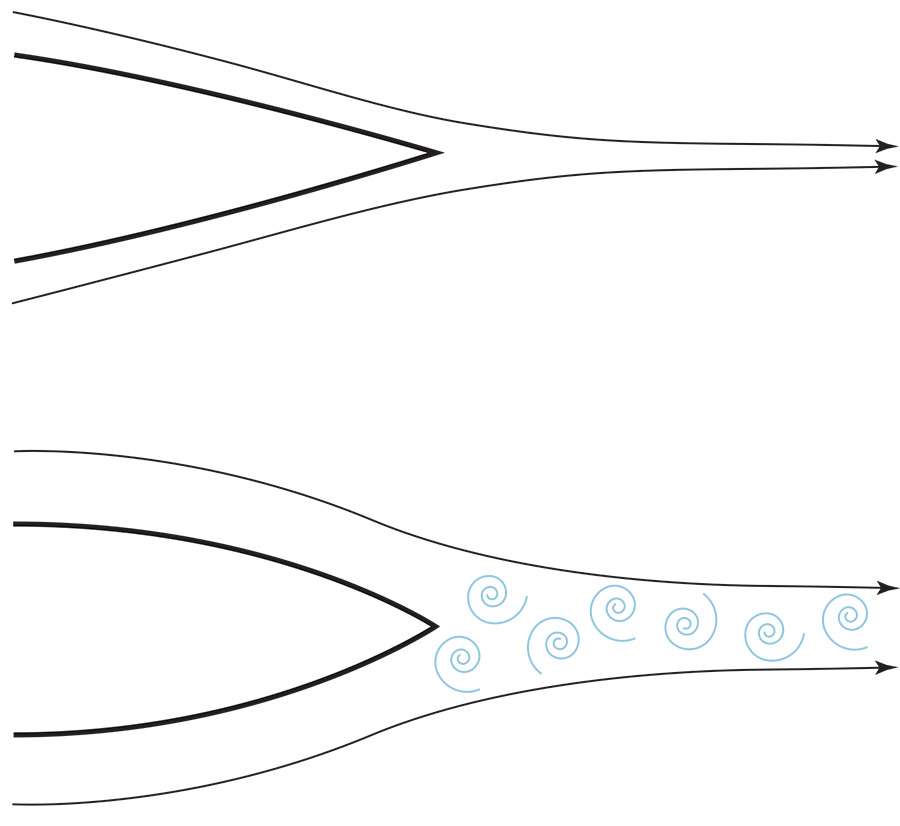
The trailing edge’s wedge angle is a critical consideration. A long, slender wedge, top, gives the best airflow separation, but is difficult to build strongly. While the larger wedge angle is easier to build, airflow separation is messier and tends to add drag. Round section trailing edges, as used on some ultralights, are the worst choice aerodynamically.
Square-cut Trailing Edges
Another approach to trailing edge design is to use a square-cut trailing edge. A thicker trailing edge is stronger, stiffer, and easier to build than a thin, sharp trailing edge, but presents a different set of aerodynamic issues than a sharp trailing edge.
As we have seen, a square-cut trailing edge provides a clean separation of the airflow from the airfoil, thus maintaining the vital Kutta condition. Unlike with a sharp trailing edge, the upper-surface flow here separates from the upper corner of the trailing edge, and the lower-surface flow separates from the lower corner. This leaves a separated wake behind the vertical portion of the trailing edge. This wake causes some drag.
In some cases, the base drag caused by the separated wake behind a square trailing edge may be offset by other favorable aerodynamic effects of squaring the edge. When an airfoil with a sharp trailing edge has a non-zero wedge angle, the air near the trailing edge has a problem. Air following the upper surface is going one way, and the air following the lower surface is going another. The two airstreams cannot cross over each other at the trailing edge. They must be parallel as they leave the airfoil. To become parallel, the two airstreams must leave the surfaces of the airfoil at some point upstream of the point of the trailing edge. Accordingly, an airfoil with a finite trailing-edge angle will always have a small zone of separated flow just upstream of the trailing edge. This small separated zone forms a wake very similar to the wake behind a squared-off trailing edge. When the airfoil is placed at a positive angle of attack in order to produce lift, the wake moves upward slightly. This has the same aerodynamic effect as reducing the camber of the airfoil; it reduces the lift the airfoil is producing.
On an airfoil with a squared-off trailing edge, the airfoil surfaces fill in the separated zone on the sharp-trailing-edged airfoil. This moves the wake from on the surface of the airfoil to the area behind the trailing edge. This wake stays put behind the chopped trailing edge and does not move around with changing angle of attack. Because of this, an airfoil with a square-cut trailing edge will have a higher lift-curve slope than one with a pointed, finite-wedge-angle trailing edge. The airfoil with the chopped trailing edge will produce slightly more lift at the same angle of attack than a sharp-trailing-edged airfoil. The benefit of the chopped trailing edge can be increased if upper and lower surfaces of the airfoil are parallel at the trailing edge. The thickness of the squared-off trailing edge makes it possible to do this structurally.
The drag of an airfoil with a squared-off trailing edge will not be higher than that of an airfoil with a sharp trailing edge, as long as the height of the chopped-off edge (and the wake behind it) is no larger than the wake caused by the separation ahead of the sharp trailing edge would have been. In most cases, this means that the drag of an airfoil will not increase noticeably until the trailing-edge thickness is above about 0.5% of its chord. By designing an airfoil with a square-cut trailing edge, a designer can produce a section which is structurally superior, and aerodynamically at least as good as a sharp-trailing-edged airfoil.
A chopped trailing edge has a large effect on the hinge moments of control surfaces. Because the separated zone near the trailing edge is eliminated, the aerodynamic effectiveness of the aft portion of the control surface is increased. This causes two effects. First, the control surface is crisper and more effective. Because the wake is filled in, the surface does not have to move as far to cause a change in lift. It will be more effective, particularly at small deflections. Many competition aerobatic airplanes exploit this effect to improve their performance in rolling and hesitation-rolling maneuvers.
The second effect of a square trailing edge is increased hinge moment. A surface with a square-cut trailing edge will feel heavier to the pilot. This effect can be used to cure control sensitivity. Adding small wedges, point forward, to both sides of a control surface, can give all or part of it a squared-off trailing edge, making the control feel heavier. The feel of the control can be tailored by altering the size of the wedges, and the amount of trailing-edge length they cover. If the total height of the pair of wedges is kept below 0.5% of the chord, they will produce little or no drag increase.
Rounded Trailing Edges
Sometimes, it seems structurally desirable to make a trailing edge round. It is, for example, easy to use a single tube as a trailing-edge spar.
Round trailing edges are undesirable because there is no clearly defined corner to cause the air to leave the airfoil and flow downstream. At positive angles of attack, the lower-surface flow tends to stay attached to the radius of the round trailing edge, and wrap around towards the upper surface. This has an effect similar to deflecting a flap upward. The air that has wrapped around the trailing edge eventually separates, but the direction it leaves the airfoil is different than it would have been if the airfoil had a sharp trailing edge. The airfoil with the round trailing edge loses some lift because it does not deflect the air down as much as the sharp-leading-edge airfoil.
The magnitude of this undesirable effect is determined by the radius of the round trailing edge. If the radius is small enough, the air will separate without wrapping around very much and the lift penalty will be small.
It is relatively common practice on metal airplanes to form trailing edges of bent sheet material. These bent-sheet trailing edges have a small radius at the bend that forms the trailing edge. This radius is a little larger than twice the material thickness of the skin, and is almost always too small to cause any detectable aerodynamic effect.
Many traditional tube-and-fabric airplanes have control surfaces which have tubing frames covered with fabric. The trailing edges of these surfaces are typically small-diameter tubes. In most cases, these control surfaces work fine, and the undesirable effect of the round trailing edge is small enough to be negligible.
A more extreme example of round trailing edges can be found on some ultralights, which have aluminum-tube ladder wing structures. On some of these airplanes, the trailing edge can be more than an inch in diameter. At this point, the roundness of the trailing edge is probably hurting both lift and drag. For most ultralights, performance is not of prime importance. In such a situation, the simplicity and low-cost advantages of the simple-tube trailing edge may outweigh the aerodynamic penalty it causes.
If the radius of a round trailing edge gets too large, it will cause a large increase in drag, and a large loss of lift. For most situations, a round trailing edge is quite undesirable and should be avoided, particularly if the trailing-edge diameter gets larger than 1% of the local chord.

![]()
Barnaby Wainfan is a principal aerodynamics engineer for Northrop Grumman’s Advanced Design organization. A private pilot with single engine and glider ratings, Barnaby has been involved in the design of unconventional airplanes including canards, joined wings, flying wings and some too strange to fall into any known category.










